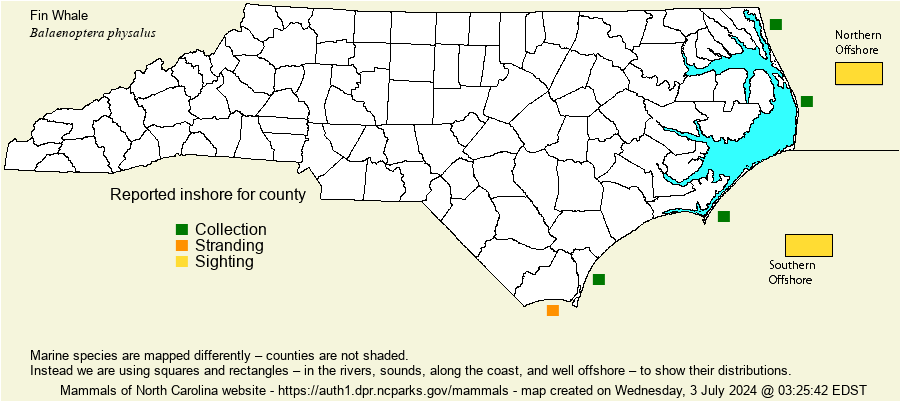|
| Distribution |
In NC, occurs offshore all along the coastline, generally away from sight of land. Despite many strandings, they all fall within just four of the eight coastal counties of the state.
Occurs worldwide in all oceans. |
| Abundance |
Rare to uncommon, but the most frequently seen Balaenoptera species in the state, and certainly is the best known of those four species. Occasionally seen from shore, but much less so than is the Humpback Whale. The Smithsonian National Museum of Natural History mammal collections (2021) lists 7 stranding records for NC. |
| Seasonal Occurrence |
Most frequently seen in winter, sparingly from fall to late spring. There were 14 strandings known in the state as of 1995 (Webster et al., 1995); all but one were from January to May, and one in November. The highest number was in January, suggestive of the peak of occurrence in NC waters. The NMNH collections database also shows this range, with no stranding records from June through October. As with other large whales, it moves north in spring and south in late fall, though it is clearly present in NC waters all winter. |
| Habitat |
Offshore waters, though can be seen somewhat inshore, within a few miles of the coast. |
| Behavior |
This is one of the fastest swimming whale species, and it is typically wary of boats. Though they can occasionally be seen in moderate-sized pods, in NC it is usually seen alone or in very small groups. |
| Comments |
This is another large whale that is listed as Endangered by the U.S. Fish and Wildlife Service. Fortunately, it is not overly rare in the North Atlantic, though numbers are greatly reduced from a century or more ago as a result of the whaling industry. |
| Origin |
Native |
| NC List |
Official |
 State Rank State Rank |
S2S3M |
| State Status |
|
 Global Rank Global Rank |
G3G4 |
| Federal Status |
E |
| subspecies |
|
| other_comName |
|
| synonym |
|


